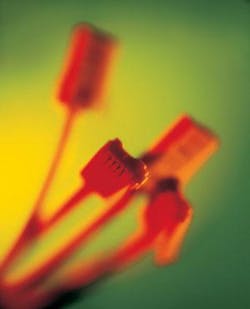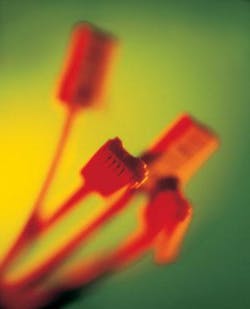Chinese Connection
Over the years, the connector-manufacturing business has grown steadily in China. In addition to the low labor cost, provincial governments are offering attractive land lease agreements and preferential policies to entice investors. The pro-business environment has attracted many foreign connector manufacturers to set up operations in China.
The connector-manufacturing industry was one of the earliest users of machine vision for product inspection. Because of the rapid introduction of new products and the relatively short life span of old products, it has always been a challenge to adapt the manufacturing process to cope with these changes. To maintain competitiveness, manufacturers are constantly focusing on how to leverage existing production capability to adapt the new challenges presented with new products. Hence, the flexibility and scalability of production equipment becomes very important.
Most of the connectors manufactured in China are used in consumer electronics such as personal computers, laptops, hand-held devices, mobile phones, and MP3 players. In the next few years, consumer electronics will continue to drive connector demand in China. Laptops, mobile phones, and hand-held devices will lead the demand for connectors.
During the early 1980s, many small and medium connector manufacturers from Taiwan and Hong Kong started to invest and set up operation in China. All of these manufacturers are concentrated in the Pearl River Delta in Southern China near Shenzhen. Major players, such as Foxconn Electronics, already had operations in China during the 1980s.
In the 1990s, China expanded and shifted its economic development focus from the Pearl River Delta to the Yangtze River Delta in eastern China. At the same time, China opened its doors for economic development. This led to a steady stream of European and American investments into China. Molex and Tyco are just some of the key connector manufacturers with operations in China.
For the past three years, the connector manufacturing industry has been considered one of the strongest drivers of machine-vision growth in China. In 2004 alone, an estimated 30%–40% of machine-vision sales in China was generated by connector-manufacturing-related applications.
Stamping and assembly
Most of the requirements for visual inspection in connector manufacturing are related to stamping and assembly processes. Human inspectors still fulfill 90% of the visual inspection requirements in the stamping process for three main reasons:
- The quality of the stamping equipment and its tooling have improved, leading to a significant reduction of reject parts produced. Therefore, the need for 100% visual inspection is greatly reduced.
- Machine vision is a relatively new concept and technology in China. The acceptance level is still relatively low among users in the stamping process. There is a lack of understanding of how machine vision can enhance this process. Most of the users are approaching the technology conservatively with a lot of skepticism.
- The biggest challenge lies in the user’s perception of return on investment. Instead of weighing the accumulated benefits and savings against initial investment over a period of time, users typically focus on the initial amount of investment. For example, users would rather pay in installments than pay in full for a machine-vision system. This has indirectly led to a small installed base among connector manufacturers. To keep prices low, solution providers usually propose systems using smart cameras.
Machine-vision systems are more widely used in the final assembly process. This process involves numerous stages of manual assembly by human operators and is very common among local Chinese connector manufacturers. Therefore, final product quality needs to be verified before shipping to customers.
For the past two years, approximately 85% of machine-vision applications sold in the assembly process are related to final product-quality inspection. Therefore, most of the local machine-vision solution providers and suppliers focus their efforts in this market segment.
Market opportunities
In the connector-inspection market, 95% of the machine-vision applications are based on smart cameras. The preference toward smart cameras can be derived from the facts that
- Local solution providers lack the knowledge and ability to develop complex PC-based solutions.
- Initial investment is relatively lower than PC-based solutions.
- Smart cameras are perceived to be more flexible and scalable solution compared to PC-based systems.
- Reconfiguring and redeploying a smart camera is simpler and requires relatively less time.
However, only a handful of local solution providers are able to provide turnkey solutions in connector inspections.
The Chinese connector-manufacturing industry represents a huge potential market for machine-vision products and solutions. But, the market is difficult to exploit. For the local solution providers, the biggest challenge is the lack of engineering capability to deliver turnkey solutions. For the foreign solution providers, the biggest obstacle is the lack of market understanding in the Chinese connector industry.
The connector manufacturers in China can be classified into three types: 1) foreign (100%) owned companies; 2) joint-venture companies, and 3) local Chinese companies. Approximately 70% of the machine-vision sales generated from the connector-manufacturing industry comes from Type 1 companies, such as Molex, Tyco, and Foxconn. Remaining sales are generated from the Type 2 companies; while sales generated from Type 3 are negligible.
The amount of spending in machine-vision systems indicates the level of acceptance of machine vision in factory and process automation. For example, engineers from Type 1 companies will be more machine vision savvy compared engineers from Type 3 companies. However, that does not mean that Type 1 companies are easy targets and there is no potential in Type 3 companies.
There are also challenges when dealing with Type 1 companies. Most of the Type 1 companies in China are purely manufacturing operations with limited or no autonomy on capital-spending decisions. All major capital spending has to be driven and approved by their respective head offices. This is not a problem with Type 3 companies, where decisions are made locally.
For machine-vision companies that wish to penetrate this market in China, it is important to approach Type 1 companies with a two-level sales strategy. First, establish and maintain relationships with the local users through a local Chinese partner. At the same time, promote products and services to the decision makers in the head office. As more companies begin to centralize procurement for global operations, getting certified as an approved supplier or vendor will provide an edge over competition.
Type 3 companies are a new market segment that will take time to mature. The approach is to engage a local partner to establish and maintain relationships. These companies will eventually become growth drivers when the market reaches saturation.
To cope with the limited engineering capabilities of local Chinese partners, the sales process should be simplified. Standard applications should be identified and preconfigured as standard turnkey solutions. The emphasis should be to focus on selling solutions rather than products or components. This approach will help change the perception of end users that machine-vision applications are complicated.
Periodic market surveys should be conducted to constantly monitor the trend and development in the Chinese consumer electronics market. These surveys will provide an indication of what lies ahead in the Chinese connector industry.
Tom Yang Wei is a machine-vision application engineer based in Shanghai, China; [email protected].

